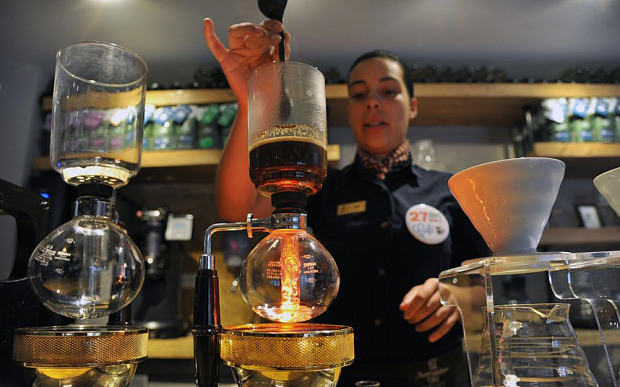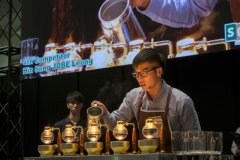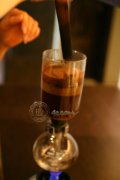The difference between hand-brewed coffee and siphon coffee: coffee size and content, water temperature and brewing time

Professional coffee knowledge exchange more coffee bean information please follow the coffee workshop (Wechat official account cafe_style)
Timeless siphon pot coffee explanation | principle and brewing suggestion of siphon pot coffee
The prototype of hand-brewed coffee was invented by an Englishman named BIGGIN, because when coffee was introduced to Britain, the Turkish soaking method was introduced to make coffee, and the British liked coffee but did not like the taste of coffee grounds, so this Mr. BIGGIN invented the prototype of velvet filtered coffee at the end of the 17th century, called BIGGIN, and then in the early 18th century. The French also invented a metal filter, but most people still like to use BIGGIN, so it was not until Europe used industrial methods to brew coffee by machine, this hand-brewed coffee utensils were used and carried forward by the Japanese.
Siphon coffee maker is most common in Taiwan and Japan. It is said that it was first invented by Scottish shipbuilder Robed Napier and appeared in Germany in 1830. Finally, it was continuously improved by France and Britain into the upper and lower parts. Under the action of heating and atmospheric pressure, heating makes the water go up (the water is heated and vaporized), and after the heat is turned off, the coffee is filtered down (the water steam cools but the condensation volume shrinks). The coffee bar, which is soaked and filtered, is so delicious that the maker looks like a researcher.
Material:
Since the development of hand-made coffee, it has been divided into two groups from the filter materials used. Flannel is used in the old school, but less is used at present. The new school uses disposable filter paper, and the two schools have their own advantages and disadvantages and supporters. Flannel has concerns about unsanitary and repetitive flavors, while paper filtration is quick and hygienic, but the Crema in the coffee is sucked away, and the flavor is obviously not as mellow as flannel.
The filter in the middle of the siphon coffee maker always uses flannel and has never seen any other substitute.
Size and amount of coffee:
Both requirements for coffee thickness and quantity are the same, according to the SCAA cup test standard will be too light, can drink a little more, I suggest that the 250ml water use 25 grams of coffee beans, and the grinding scale at 3 is more appropriate.
Water temperature and brewing time:
The approximate time for hand-brewing coffee will be 2 minutes, 30 minutes and 45 seconds. There are still many coffee makers in Japan who like to brew more than 4 minutes, while the water temperature is about 90 degrees. If the water temperature is lower or rougher, the brewing time will be prolonged. The extraction time of the siphon coffee pot is at least 2 minutes shorter than that of the hand brewing, and the extraction is usually completed in 45 minutes and 50 seconds. Although the extraction time is short, the water temperature is about 2 degrees higher than that of the hand, almost using boiling water above 90 degrees. However, don't forget that the water temperature of the hand coffee will drop, while the siphon pot is on the contrary, and it will always rise. So if the soaking time is too long, it will affect the flavor.
In addition, the hand flushing filtration method has a relatively large flavor change, and the different techniques, temperature and water flow rate will affect the flavor change; on the contrary, siphon has less flavor, and the adjustment space for coffee bean flavor is not as rich as that of hand flushing. As long as the production does not fail, it is almost easy to standardize.
My opinion on the difference of taste:
The hand is unstoppable, and the greatest charm of the hand is that it can drink a variety of other flavors of coffee, whether the fruit is sour or firm, rich and multi-layered, and the front, middle and aftertaste are very obvious. On the other hand, the coffee liquid extracted by siphon coffee is not just brewed. Due to the atmospheric effect of hot expansion and cold contraction, the coffee essence in coffee beans seems to have been extracted, so although the siphon extraction time is short, it is very strong. Caffeine is also heavy.
From the traditional perception that most people drink coffee, I still prefer the bitter but gentle thickness of coffee to the stimulating bitterness of cracking. Siphon coffee can be done, and hand-brewed coffee is full of flavor. However, I am afraid that most people cannot accept that coffee with fruit acid or citric acid is coffee, especially in light roasting, and there is still a long way to go for consumers to accept it.
As for why "boutique coffee" is made by hand with filter paper at present? This is because foreigners like SCAA and CoE can only use filter paper to make a single cup of coffee. They know it but haven't touched the siphon, so it's what it is now. In fact, I think there is no certain standard for using filter paper or flannel or siphon or mocha pots because of their own preference for coffee taste, or which tools coffee shop practitioners prefer to use to show fine coffee. Now this is the trend of filter paper, and even an one-time earbag can also make good coffee.
.
Important Notice :
前街咖啡 FrontStreet Coffee has moved to new addredd:
FrontStreet Coffee Address: 315,Donghua East Road,GuangZhou
Tel:020 38364473
- Prev

The difference between a mocha pot and a siphon pot how to use a siphon coffee maker with alcohol lamp heat source
Professional coffee knowledge exchange more coffee bean information please follow the coffee workshop (Wechat official account cafe_style) timeless siphon pot coffee explanation | siphon pot coffee principle and brewing suggestion for 10 years, has been resistant to other ways of cooking coffee, think it is not as pure and full-bodied as the mocha pot. Among several other options, feel siphon (Sy
- Next

Explanation of brewing skills of siphon coffee pot: how to judge the timing of coffee mixing and flameout in siphon pot
Professional coffee knowledge exchange more coffee bean information please follow the coffee workshop (Wechat official account cafe_style) timeless siphon pot coffee explanation | siphon pot coffee principle and brewing suggestion before pouring into the coffee powder, try to smell the freshly ground beans, remember this flavor (mainly beans to freshly roasted coffee beans) boil the kettle until completely boiled, and cook
Related
- What is the Philharmonic pressure? How to use Philharmonic pressure to make delicious coffee
- Why does a hand grinder have more fine powder than an electric grinder?
- In addition to the hot mom, what is the difference between the versions of EK43 | ditting and Mahdi ek43?
- What kind of equipment do you need to make coffee by hand? Introduction to novice starter cooking equipment tools
- Espresso needs to be ground how thick and thin scale entry Italian Coffee Machine Bean Grinder investigation and Grinding course
- How much does it cost to open a small private cafe? How much does it cost to learn coffee? How to operate it?
- The difference between the flavor characteristics of hand-brewed coffee and coffee maker is hand-brewed coffee really better than coffee maker? Can I use a coffee machine to make coffee beans by hand?
- The difference between 01 and 02 of hario v60 filter cup what is the difference between 01 and 02 filter cup opening and cooking flavor
- What's the difference between the smart cup and the French kettle? Which is better, the French kettle or the Smart Cup?
- What's the difference between a smart cup and a V60 filter cup? The difference between the taste of smart cup and hand-brewed coffee

